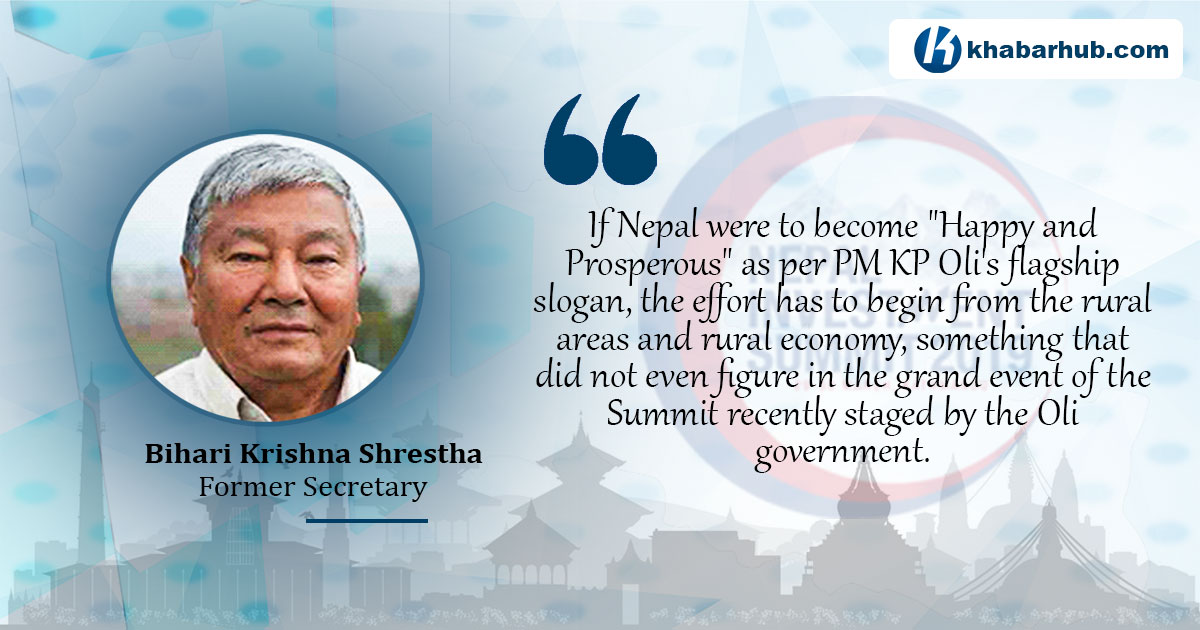The KP Oli government organized the fifth version of the Nepal Investment Summit with great fanfare, and announced that of the 77 development projects submitted to the Summit, quite a few of them (15) have been already signed, ten have been formally applied for by the potential investors, and the rest of them too are now followed up by different participating firms with keen interest. For this reason, the Summit has been declared a grand success.
Although done in last minute, the government also demonstrated its commitment by rushing through the parliament a few important legislation that would positively impress the summiteers about Nepal’s seriousness of purpose for making Nepal foreign investment friendly.
While similar summits earlier too did not lack in drama, the result so far has been rather disappointing, even in the case of the one organized for resources mobilization for earthquake reconstruction. The default has been double-edged.
The PM in his address assured the delegates that Nepal now is a profitable destination for investment and that they would undergo no hassles in repatriating their profits. Clearly, the Oli government has taken this summit as its flagship initiative for national development, and Oli himself would like to establish it as his legacy.
While similar summits earlier too did not lack in drama, the result so far has been rather disappointing, even in the case of the one organized for resources mobilization for earthquake reconstruction. The default has been double-edged.
While the government, in keeping with its long-standing history, has been unable to spend what resources it actually received, creating an unwelcome impression among Nepal’s donors that Nepal’s so-called “absorptive capacity” continues to be constrained and limited.
Secondly, many donors would not put their money where their mouth was. They would make a commitment in the colloquium but then would balk when asked to cough up the cash.
Despite this, it still involves lots of political tussle and bureaucratic delays almost at all levels, each of them seeking their own cuts. Under Oli government too–that has otherwise promised “zero tolerance” against corruption–such delay and tussle have remained customary.
While the donors’ behavior in this regard has been their continuing usual affair across the globe mainly due to their own lack of sense of urgency and ownership and customary bureaucratic delays, Nepal’s side of the story remains even more sordid. For one thing, Nepal’s actions have never been free from political and bureaucratic corruption in particular. This one factor alone nearly guarantees the lack of timely and fruitful spending of resources.
As things stand, every single politician at any level remains corrupt, bent on taking his/her cut in any deal, by literally auctioning off of all appointments to lucrative positions to the highest bidder, that is, positions where one can make illicit money by making compromises on the quality and timeliness of the work done by formally appointed contractors or by disguised contractors in the form of pseudo user groups whose members are handpicked by the corrupt politicians of the party in power.
Despite this, it still involves lots of political tussle and bureaucratic delays almost at all levels, each of them seeking their own cuts. Under Oli government too–that has otherwise promised “zero tolerance” against corruption–such delay and tussle have remained customary.
For instance, the decades-long Melamchi project has recently been abandoned by the latest Italian contractor who has since gone public with disclosure as to how they were all along harassed by demands for “cuts” by just about every single official in the organization in which even the minister, otherwise the daughter-in-law of the fellow President of Oli’s party, Prachanda, is implicated. Given such a situation in Nepal, it would be too early to celebrate the Summit as a real success.
National development priority
Then, there is the other, a democratically and morally more compelling issue that the flow and glitter of the Summit seem to have overshadowed, however inadvertently. While most of the proposed investment in the summit is for infrastructure and energy-related projects, centered mostly on urban industrial context, those projects are not likely to make any significant dent on the country’s overall poverty which is mainly rural in Nepal.
By any definition, rural people and agriculture economy must constitute the top concern of the government to which the Investment Summit, among many its other decisions, clearly did not do any justice.
While some 82 percent of the population remains rural, agriculture provides 71 percent of employment in the country. But the sector’s contribution to the GDP currently stands only at 29 percent, suggesting massive productivity problems in agriculture and disguised unemployment of the rural workforce.
This means that if Nepal were to become “Happy and Prosperous” as per PM Oli’s flagship slogan, the effort has to begin from the rural areas and rural economy, something that did not even figure in the grand event of the Summit recently staged by the Oli government.
This seemingly misplaced priority notwithstanding, we must try to hold the government to account by recalling the fact that President Bidya Devi Bhandari, dwelling on policies and programs of the government, had told the parliament last May that the government would double the per capita income of the country in five years and also create sufficient employment opportunities domestically to make foreign employment redundant for Nepal’s underemployed workforce.
By any definition, rural people and agriculture economy must constitute the top concern of the government to which the Investment Summit, among many its other decisions, clearly did not do any justice.









Comment